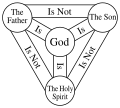File talk:Shield-Trinity-Scutum-Fidei-English.svg
Urdu
[edit]Any one can make for urdu?.--Bukhari Talk 11:09, 19 December 2017 (UTC)
- User:BukhariSaeed -- there are Arabic and Farsi versions. If you're happy with that script style, and provide the necessary text, I could do something along the same lines. I wouldn't be able to do an Urdu-specific calligraphic font... AnonMoos (talk) 08:24, 23 December 2017 (UTC)
-
Arabic
-
Persian
- @AnonMoos: Thanks but i don't understand persian & arabic i can give you eng-ur text.
- eng-ur:
- The Father = باپ
- The Son = بیٹا
- The Holy Spirit = روح القدس
- Is = ہے
- Is not = نہیں ہے
- God = خدا
- ۔۔--Bukhari Talk 08:32, 23 December 2017 (UTC)
- eng-ur:
- In the word "نہیں ہے" as it displays in my browser, none of the letters are joined to any of the other letters -- is that intentional or a mistake? Are the letters "nun", "choti he", "ye", "nun ghunna", "ye barree"? AnonMoos (talk) 09:04, 23 December 2017 (UTC)
- @AnonMoos: نہیں means = no & ہے means is, no it's not mistake.--Bukhari Talk 11:40, 23 December 2017 (UTC)
- if urdu "ی" is not working use "ي" in "nahi". now try "نہيں"--Bukhari Talk 11:43, 23 December 2017 (UTC)
- @AnonMoos: نہیں means = no & ہے means is, no it's not mistake.--Bukhari Talk 11:40, 23 December 2017 (UTC)
This image shows how what you typed above displays in my browser. As you can see, number 2 is not fully joined, while number 5 is not joined at all (and so looks quite strange to me). If that's what you want it to look like, I can make it look like that, but I suspect otherwise... AnonMoos (talk) 01:24, 24 December 2017 (UTC)

- I don't know why this is happening. :(--Bukhari Talk 05:47, 2 January 2018 (UTC)
- It's presumably happening because I don't have Urdu-specific extensions installed in my operating system. and my browser is taking Urdu-specific characters from several different fonts and is having problems joining them together. But that's not the issue. The issue is "WHAT IS 5 SUPPOSED TO LOOK LIKE?" (and to a lesser degree 2). Once you answer that question, then I can actually start working on the graphic... AnonMoos (talk) 15:43, 2 January 2018 (UTC)
- 2. بيٹا
- 5. نہيں ہے
- I think you should try arabic alphabet "ي" in above two instead of urdu alphabet "ی" then it will may work.--Bukhari Talk 14:15, 4 January 2018 (UTC)
- I'm really really sorry, but 2 and 5 as you typed them above look like they always look in my browser -- exactly as in image File:Urdu-translation-rendering-working-TEMPORARY.png, except for the dots under the ي (which do not change the lack of character joining). I really don't think it's a productive use of anyone's time and efforts to try to figure out how to coerce my old operating system and old browser version to display Urdu correctly. Instead, you need to give me some positive indications as to how they should display (such as a screenshot in your browser with text magnification)... AnonMoos (talk) 02:59, 5 January 2018 (UTC)
- @AnonMoos: i think Odder can help in this situation — Bukhari (Talk!) 09:20, 15 February 2018 (UTC)
- Unfortunately not, I'm currently on holiday with intermittent internet access (and very little time) and I won't be able to be involved with this at all over the next three weeks or so; sorry! odder (talk) 14:41, 15 February 2018 (UTC)
- @AnonMoos: Please change your fonts and then try again — Bukhari (Talk!) 04:31, 23 March 2018 (UTC)
- Unfortunately not, I'm currently on holiday with intermittent internet access (and very little time) and I won't be able to be involved with this at all over the next three weeks or so; sorry! odder (talk) 14:41, 15 February 2018 (UTC)
- @AnonMoos: i think Odder can help in this situation — Bukhari (Talk!) 09:20, 15 February 2018 (UTC)
- I'm really really sorry, but 2 and 5 as you typed them above look like they always look in my browser -- exactly as in image File:Urdu-translation-rendering-working-TEMPORARY.png, except for the dots under the ي (which do not change the lack of character joining). I really don't think it's a productive use of anyone's time and efforts to try to figure out how to coerce my old operating system and old browser version to display Urdu correctly. Instead, you need to give me some positive indications as to how they should display (such as a screenshot in your browser with text magnification)... AnonMoos (talk) 02:59, 5 January 2018 (UTC)

The fonts I have that my browser is probably using are "Arial Unicode MS" and "Symbola", Even if I had Urdu-specific fonts, they might not display correctly without an Urdu-capable operating system. As I said before, I don't think it's a productive use of anyone's time to try to coerce my old browser and old operating system to display the correct joining. If someone can show me what the correct joining should look like, then I could proceed... AnonMoos (talk) 16:32, 23 March 2018 (UTC)

@BukhariSaeed: -- I was finally able to do it after Tuvalkin's help (thanks). See File:Shield-Trinity-Urdu.svg. Sorry if the stylistic feel isn't very Urdu, but I'm using a general Arabic font, not an Urdu-specific font, as I told you at the very beginning... -- AnonMoos (talk) 23:00, 1 April 2018 (UTC)
- Thanks :) — Bukhari (Talk!) 02:54, 2 April 2018 (UTC)


